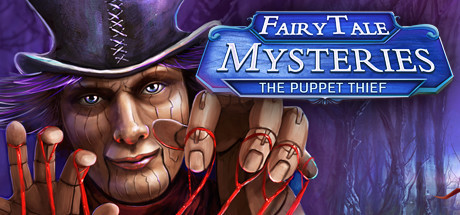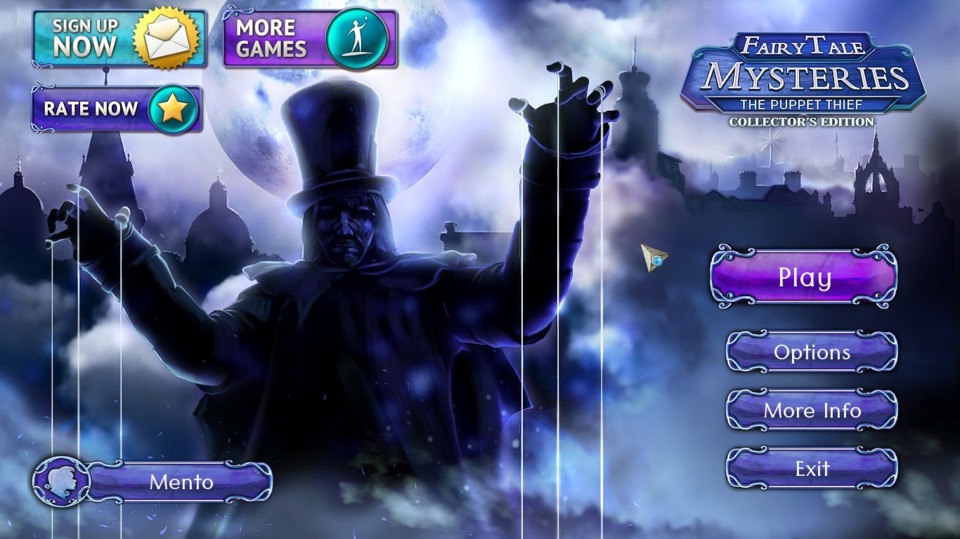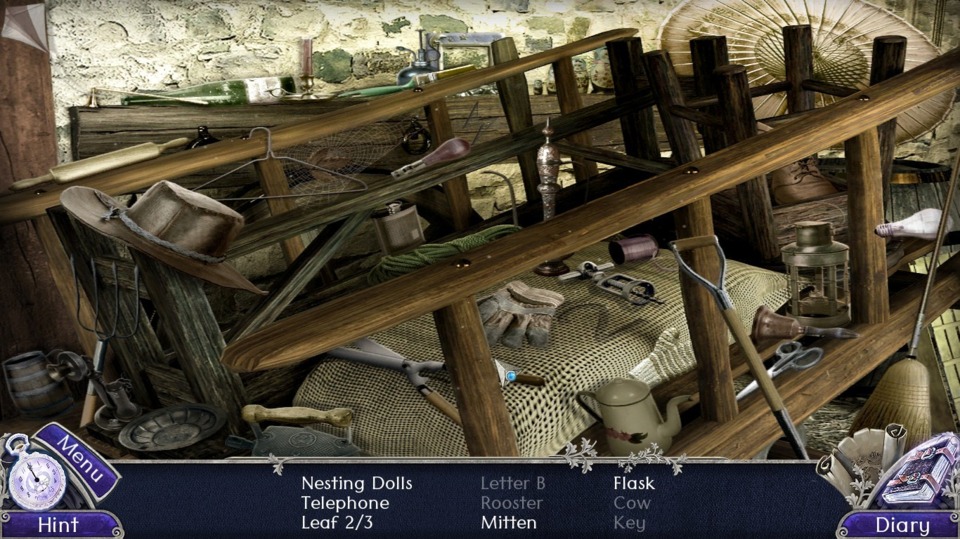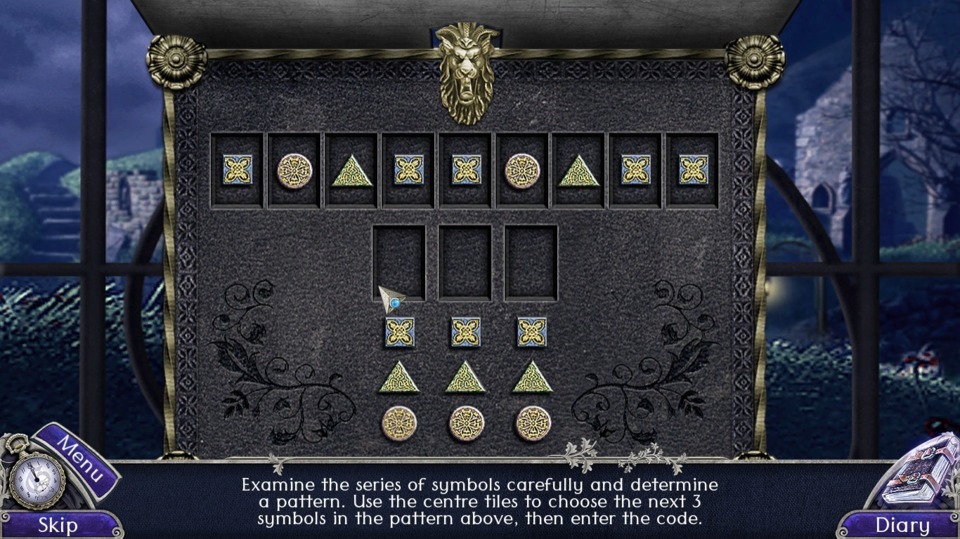Rainy Days and Mundis: Episode 5
By Mento 0 Comments
Pick up your clickers and squint your eyes with your head askew, because we're heading back to the arbitrary world of Hidden Object Puzzle Adventure games, or HOPA: an acronym I recently learned was not in wide use by anyone! I've been around this concealed paraphernalia mill a few times now, as evinced by the numerical in the blog title, and yet this week opened my eyes to a few new unfortunate realities. What happens when you have a bad HOPA? And how does that inadvertently help you appreciate the high-quality HOPAs you've seen so far? Well, we're about to learn all about that unpleasant sensation firsthand with Fairy Tale Mysteries: The Puppet Thief.
To be fair to The Puppet Thief, I suspect the reason for its general mundanity - and I'm talking comparatively here, since all the HOPAs I've seen so far have been mediocre in their own special way - is that it runs on a far older version of the HOPA blueprint, devoid of many quality-of-life features or the puzzle variation seen in the others I've played. I originally pegged it as a 2016 game, as that's what both the publisher website (our old friends and feature namesake, Artifex Mundi) and Steam itself claims, but evidence across the web suggests that we're looking at a December 2012 release - positively ancient in comparison to those we've played before. It has two apparent developers: The House of Fables, a Polish team better known for their three-strong Eventide series who have more recently moved into VR games, and the Canadian Gogii Games, who jumped from the loving arms of Artifex Mundi to create a series of HOPA games for a different publisher - Strategy First - in what I can only assume was a sordid tale of betrayal and simmering resentment. Or because Strategy First is also based in Canada and was probably more convenient for them, but where's the fun in assuming that?
Before we move onto the main event, here are the previous episodes:
- Episode 1: Grim Legends: The Forsaken Bride
- Episode 2: The Myth Seekers: The Legacy of Vulcan
- Episode 3: Tiny Tales: Heart of the Forest
- Episode 4: Grim Legends 2: Song of the Dark Swan
Episode 5: Fairy Tale Mysteries: The Puppet Thief

The Puppet Thief is inspired by the legend of the Pied Piper of Hamelin and features a creepy marionette on its Steam icon; this led me to erroneously believe that this was a horror game, and as such a different theme to explore with this feature. Instead, it's more reheated fairy tale nonsense, like almost everything else I've covered so far. I may have come across another failing of this genre: so infrequently do they cover anything but fairy tales and mythology. Take the previous games, seen above: a fairy tale about a demon coming back for a child after an ill-advised promise (so, Rumpelstiltskin, more or less); a fantastical, archeological tale about ancient Roman gods; a magical take on the Borrowers; and another fairy tale, this time loosely based on Swan Lake (or more perhaps more specifically on the 1994 not-Disney movie The Swan Princess, given the level of writing). If you think I'm just been unlucky with these choices, the other HOPA games I have in reserve include: one on the Philosopher's Stone myth; one on demons and magical stones in a lost city; one on Slavic myths; one on Tibetan myths; and another one based on the Philosopher's Stone. I swear, the developers of these games are stuck in a thematic rut, as well as about five other ruts. (Can you be stuck in multiple ruts? Maybe if they criss-crossed.) At any rate, it feels like the HOPA genre is scuppered with a lack of imagination at every turn.
That's especially true of The Puppet Thief (having finally found my way back to the matter at hand), as it is comprised almost entirely of "traditional" hidden object scenes. By which I mean, the type where they give you a list of words and you have to pick them out of a tableau. We've seen before now a number of different ways to deliver a list of objects to the player, from single instances of the same repeated object type (like tiles or cards) to silhouettes to broken components of an elaborate construction, but The Puppet Thief isn't interested in any of that. In some ways, I almost respect it, but like in a begrudging way that you might respect something after it wasted four hours of your life.
I'll quickly put together the puzzle breakdown to demonstrate:
- Of the fifty-two puzzles in the game, an incredible 34 of those (around 65%, or two-thirds) are hidden object screens. Furthermore, all but one of those were the basic "list of words" variant, the one exception being a screen where you had to find twelve panels to complete the final sliding block puzzle of the game. In addition to that, eleven of those remaining 33 were repeats - that is to say, they used the same hidden object screen again, just with different targets.
- Of the eighteen actual puzzles in the game, an impressively banal eight of those were sliding block puzzles. I generally consider any puzzle where you move existing objects around a grid so that everything is in their proper place as a sliding block puzzle: in this case, we have two of the annoying kind where you only have a gap to work with, three more of the easier type where you switch the places of two adjacent items, and the last three had you spin fixed objects to their proper orientation: say, a set of rings that creates a picture when aligned right. We also had four memory match games - the Dane Cook of puzzle variants - a couple of "on/off" puzzles where different buttons arbitrarily turn on or off adjacent lights, two where you actually had to figure out a pattern cipher (hadn't seen one in a HOPA before), and - finally - a rote jigsaw and a "Simon Says" repetition challenge that turned out to be the final boss. How exhilarating.
Differences
Well, given this is a 2012 release, a lot of Artifex Mundi's "blueprint" is missing here. For one, there's no game-wide collectible hunt (though it's probably for the best). It's also graphically weaker than most of the prior games, even if they all look sorta PS2-era, and there was far less exposition beyond a few dialogue scenes. The other HOPAs I've seen so far had been replete with storybooks, journals and notes, as well as puzzles that explicitly served to deliver backstory.
However, there's still a few similarities. Something I haven't talked about much are the "DLC" campaigns: actually little bonus chapters, approximately one third the size of the core game, that I believe were added specifically for the Steam versions. I believe most of these games were initially sold on mobile devices, which has filled in a very big hole in my understanding of the genre: a game where you point at things is made all the more palatable with a touchscreen interface, though the downside is that these hidden object pictures tend to be fairly busy - you'd need a large viewing screen to effectively take in an entire image, not to mention precisely clicking on the relevant hotspots. It also has the same difficulty system - each tier removing more of the quality-of-life features and clues, if that's how you want to live your life - and the same map-based fast-travel system and interface. For as much of a prototype as the game feels with its threadbare range, it definitely has Mundi's fingerprints all over it.
Screenshots!



I believe I've reached the limits of what I can learn about this genre from playing it, not to mention the limits of my once previously bottomless patience. Next week's installation of Rainy Days and Mundis will be the last, as I move into the second quarter of the year with a fresh new feature and no small amount of regret. I'd better make it a good one, huh? How about... the most recent HOPA I own?
